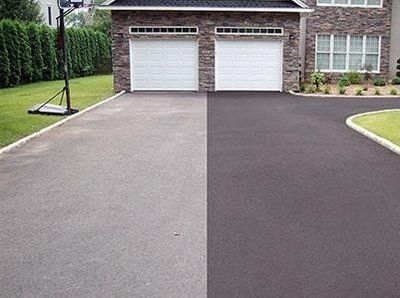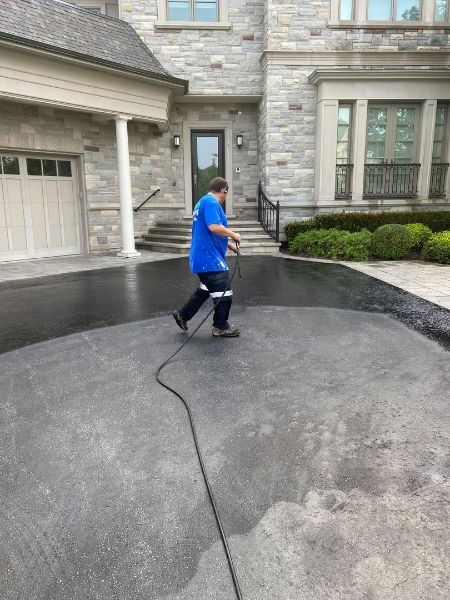Boost Commercial Appeal: Warm Mix Asphalt Sealing for Angled Parking Lots
Boost Commercial Appeal: Warm Mix Asphalt Sealing for Angled Parking Lots
Blog Article
Hot Mix Asphalt: A Lasting Remedy for Pavement
Warm Mix Asphalt (HMA) has actually arised as a leading sustainable choice for pavement options, supplying a myriad of ecological advantages and ingenious technologies. As the demand for green building and construction techniques grows, checking out the nuances of HMA's sustainability can give important understandings right into the future of sidewalk solutions.
Environmental Advantages of Warm Mix Asphalt

Furthermore, Warm Mix Asphalt assists to minimize metropolitan heat island impacts. Its dark color soaks up sunlight, minimizing the amount of warm reflected back into the environment contrasted to lighter-colored sidewalks. This can lower ambient temperatures in metropolitan locations, reducing the demand for air conditioning and ultimately minimizing power usage.
Additionally, Warm Mix Asphalt adds to boosted stormwater monitoring. Its permeable nature enables water to recharge and infiltrate the pavement groundwater products, reducing drainage and the danger of flooding. These environmental advantages make Warm Mix Asphalt a sustainable option for paving roadways and freeways.
Power Performance in HMA Production
Is power performance a critical aspect in the production of Hot Mix Asphalt (HMA)? Definitely. Energy plays a substantial role in the production of HMA, influencing both expense and ecological sustainability. One crucial aspect of energy efficiency in HMA manufacturing is the usage of cozy mix asphalt (WMA) technologies (hot mix asphalt). WMA permits the mixing and positioning of asphalt at lower temperature levels contrasted to conventional warm mix asphalt, causing decreased power intake during manufacturing. This process not only decreases gas usage however likewise decreases greenhouse gas discharges, making it a more eco-friendly choice.
In addition, improvements in plant technologies have actually led to more energy-efficient HMA production procedures. By optimizing energy usage in HMA production, the market can minimize its carbon impact while keeping top quality pavement products.
Recyclability of Hot Mix Asphalt
The recyclability of Hot Mix Asphalt (HMA) is a pivotal element of its sustainability and long-lasting ecological impact. HMA is just one of the most recycled products in the USA, with over 100 million lots of recovered asphalt sidewalk (RAP) being reused each year in new pavement construction. Recycling HMA offers a number of environmental benefits, such as minimizing the need for virgin materials, lowering power usage throughout manufacturing, and decreasing the quantity of waste sent to land fills.
The procedure of reusing HMA includes crushing the existing sidewalk, More Help squashing it into smaller items, and blending it with new accumulation and asphalt binder to create a recycled mix. Overall, the recyclability of HMA plays a significant function in advertising lasting techniques within the pavement market.

Long-Term Performance of HMA
Asphalt sidewalks demonstrate sturdiness and resilience over a prolonged duration, reflecting the long-lasting efficiency of Hot Mix Asphalt (HMA) The longevity of HMA can be credited to its ability to endure rush hour tons, severe weather, and the effects of aging. Studies have actually revealed that well-designed and correctly created HMA sidewalks can last for 20 years or even more with routine maintenance. The secret to making best use of the long-lasting performance of my sources HMA hinges on making use of premium products, adhering to best techniques in building, and executing reliable maintenance strategies. Correct drain, regular inspections, and prompt repair work are vital for preserving the architectural integrity of HMA pavements with time. In addition, advancements in HMA technology, such as using polymer-modified binders and warm mix asphalt, have even more enhanced the resilience and long life of HMA pavements. By prioritizing top quality building and upkeep techniques, HMA continues to Going Here confirm itself as a economical and lasting remedy for long-lasting sidewalk framework.
:max_bytes(150000):strip_icc()/barricade-tape-sealed-driveway-big-56a583145f9b58b7d0dd3d87.jpg)
HMA: Durability and Sustainability
Showing both longevity and sustainability, Hot Mix Asphalt (HMA) has ended up being a cornerstone in the construction of long-lasting pavement infrastructures - hot mix asphalt. HMA's longevity originates from its capability to stand up to heavy loads, severe climate condition, and high website traffic volumes, making it a reliable option for roads, freeways, and airport runways. The structure of HMA, which usually includes accumulations, binder, and filler, plays a critical role in boosting its longevity and resistance to damage
In addition, HMA's sustainability lies in its recyclability and energy-efficient manufacturing process. The capacity to recycle redeemed asphalt pavement (RAP) in new HMA mixtures decreases the need for virgin materials and lessens the environmental impact of pavement construction and maintenance. In addition, the energy performance of producing HMA exists in its lower blending temperatures compared to various other sidewalk products, leading to lowered energy intake and greenhouse gas exhausts.
Final Thought
Finally, hot mix asphalt (HMA) supplies a sustainable remedy for sidewalk with its eco friendly features. HMA's recyclability, power effectiveness in manufacturing, and long-lasting toughness make it an environment-friendly choice for roadway building and construction. By preserving natural deposits, lowering waste, and lowering greenhouse gas discharges, HMA plays an essential duty in promoting sustainability in framework growth. Its capacity to mitigate city heat island effects even more emphasizes its value in producing eco mindful and resistant pavement systems.
HMA is one of the most recycled materials in the United States, with over 100 million lots of reclaimed asphalt pavement (RAP) being recycled annually in brand-new sidewalk building.The process of recycling HMA involves crushing the existing pavement, squashing it right into smaller sized items, and blending it with new aggregate and asphalt binder to produce a recycled mix.Asphalt sidewalks show sturdiness and durability over an extensive duration, mirroring the long-lasting performance of Hot Mix Asphalt (HMA) Additionally, advancements in HMA technology, such as the use of polymer-modified binders and warm mix asphalt, have additionally enhanced the longevity and long life of HMA sidewalks. The capacity to reuse recovered asphalt pavement (RAP) in brand-new HMA blends decreases the need for virgin products and decreases the environmental impact of pavement building and maintenance.
Report this page